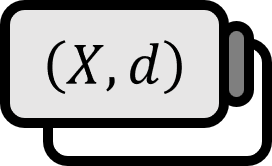Properties of Complete Metric Spaces
Properties
$(X,d)$ is a metric space and let $K \subset X$.
- [1]: $K$ is a complete subspace. $\iff$ $X$ implies $K$ is a closed set.
- [2]: $K$ is a closed set in a totally bounded space $\iff$ $X$, hence $K$ is compact.
Description
A complete metric space possesses all the usual properties one might expect from a space with completeness, being a metric space with completeness. If it becomes a normed vector space, it is called a Banach space, and if an inner product is defined, it becomes a Hilbert space. Irrespective of being a normed vector space, if it’s separable, it’s also known as a Polish space.
Proof
[1]
$(\Longrightarrow)$
Properties of Accumulation Points in Metric Spaces
$x \in X$ is an accumulation point of $K$. There exists a sequence of distinct points in $K$ converging to $x \in X$ with $\iff$ $x$.
If $x \in X$ is an accumulation point of $K$, then there exists a sequence $\left\{ x_n \right\}_{n \in \mathbb{N}}$ of distinct points in $K$ converging to $x$. Since $\left\{ x_n \right\}_{n \in \mathbb{N}}$ consists of distinct points, it is a Cauchy sequence, and since $K$ is a complete space, it must converge to $x \in K$. Therefore, $K$ is a closed set.
$(\Longleftarrow)$
Suppose $\left\{ x_n \right\}_{n \in \mathbb{N}}$ is a Cauchy sequence of points in $K$. Since $X$ is complete, $\left\{ x_n \right\}_{n \in \mathbb{N}}$ converges to some point $x \in X$. However, since $K$ is a closed set, it converges to $x \in K$, and this holds for every Cauchy sequence, meaning $K$ must be a complete subspace of $X$.
■
Strategy (b): The proof of $(\Longleftarrow)$ is trivial. After demonstrating $K$ is sequentially compact in $(\Longrightarrow)$, we use Borel-Cantelli Lemma. A metric space $K$ being sequentially compact means every sequence in $K$ has a subsequence that converges to a point in $K$.
[2]
$(\Longrightarrow)$
Consider $\left\{ x_n \right\}_{n \in \mathbb{N}}$, a sequence of points in the closed set $K$. For all $m \in \mathbb{N}$, there exists $1/m$-ball $A_{\varepsilon}$ around $K$, so there always exists an open ball $B_{m} := B_{d} ( x, 1/m)$ that contains infinitely many points of $n \in \mathbb{N}$ for an infinite number of $x_{n}$. For $m=1$, let’s define $N_{1} \subset \mathbb{N}$ as $N_{1} := \left\{ n : x_{n} \in B_{1} \right\}$. Here we choose $n_{1} \in N_{1}$. For $m=2$, let’s define $N_{2} \subset \mathbb{N}$ as $N_{2} := \left\{ n : x_{n} \in B_{1} \cap B_{2} \right\}$. Here we choose $n_{2} \in N_{2}$. In this manner, for every $m=k \in \mathbb{N}$, let’s define $N_{k} \subset \mathbb{N}$ as $N_{k} := \left\{ n : x_{n} \in \bigcap_{i=1}^{k} B_{k} \right\}$. Here we choose $n_{k} \in N_{k}$. Then, $\left\{ x_{n_{k}} \right\}_{k \in \mathbb{N}}$, being a subsequence of $\left\{ x_n \right\}_{n \in \mathbb{N}}$, is a Cauchy sequence for every $l \ge k$ due to $x_{l} \in B_{k}$. Since $X$ is complete, $\left\{ x_{n_{k}} \right\}_{k \in \mathbb{N}}$ converges to a point in $X$, especially since $K$ is a closed set, it converges to a point in $K$.
For a metric space $(X, \rho)$, the following are equivalent:
$X$ is a compact space.
$X$ is sequentially compact.
$X$ is complete and totally bounded.
Since we have shown that every sequence in $K$ has a subsequence that converges to a point in $K$, $K$ is sequentially compact, and according to Borel-Lebesgue Theorem, the closed set $K$ is compact.
$(\Longleftarrow)$
Since the closed set $K$ is compact, for all $\varepsilon>0$ there exists a $\varepsilon$-net in $K$. Therefore, $K$ is totally bounded.
■
